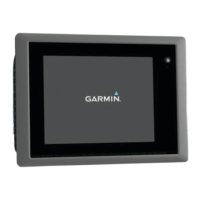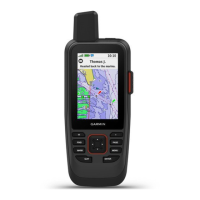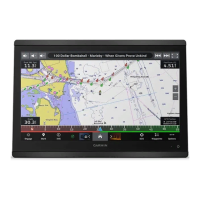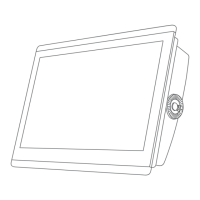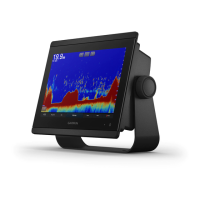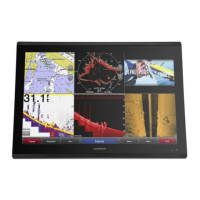Viewing the DSC List
Before you can view the DSC list, the chartplotter must be connected to a VHF radio that supports DSC.
Select Info > Other Vessels > DSC List.
Adding a DSC Contact
You can add a vessel to your DSC list. You can make calls to a DSC contact from the chartplotter.
1 Select Info > Other Vessels > DSC List > Add Contact.
2 Enter the Maritime Mobile Service Identity (MMSI) of the vessel.
3 Enter the name of the vessel.
Incoming Distress Calls
If your compatible chartplotter and VHF radio are connected using NMEA 0183 or NMEA 2000, your chartplotter
alerts you when your VHF radio receives a DSC distress call. If position information was sent with the distress
call, that information is also available and recorded with the call.
designates a distress call in the DSC list and marks the position of the vessel on the Navigation chart at the
time of the DSC distress call.
Navigating to a Vessel in Distress
designates a distress call in the DSC list and marks the position of a vessel on the Navigation chart at the
time of the DSC distress call.
1 Select Info > Other Vessels > DSC List.
2 Select a position-report call.
3 Select Review > Navigate To.
4 Select Go To or Route To.
Man-Overboard Distress Calls Initiated from a VHF Radio
When the chartplotter is connected to a compatible VHF radio with NMEA 2000, and you initiate a man-
overboard DSC distress call from the radio, the chartplotter shows the man-overboard screen and prompts you
to navigate to the man-overboard point. If you have a compatible autopilot system connected to the network,
the chartplotter prompts you to start a Williamson’s turn to the man-overboard point.
If you cancel the man-overboard distress call on the radio, the chartplotter screen prompting you to activate
navigation to the man-overboard location disappears.
Man-Overboard and SOS Distress Calls Initiated from the Chartplotter
When your chartplotter is connected to a Garmin NMEA 2000 compatible radio and you mark an SOS or
man-overboard location, the radio shows the Distress Call page so you can quickly initiate a distress call.
For information on placing distress calls from your radio, see the VHF radio owner’s manual. For information
about marking an MOB or SOS location, see Marking a Man Overboard or Other SOS Location, page55.
Position Tracking
You can connect a VHF radio to the same NMEA 2000 network as the chartplotter to send position reports and
track vessels that send position reports. The vessel must send the correct PGN data (PGN 129808; DSC Call
Information) to use this feature.
You can connect the chartplotter to a VHF radio using NMEA 0183, to send position reports and track vessels
that send position reports.
Every position report call received is logged in the DSC list (DSC List, page123).
124 Digital Selective Calling
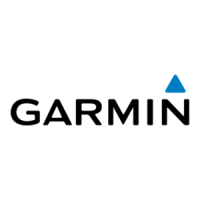
